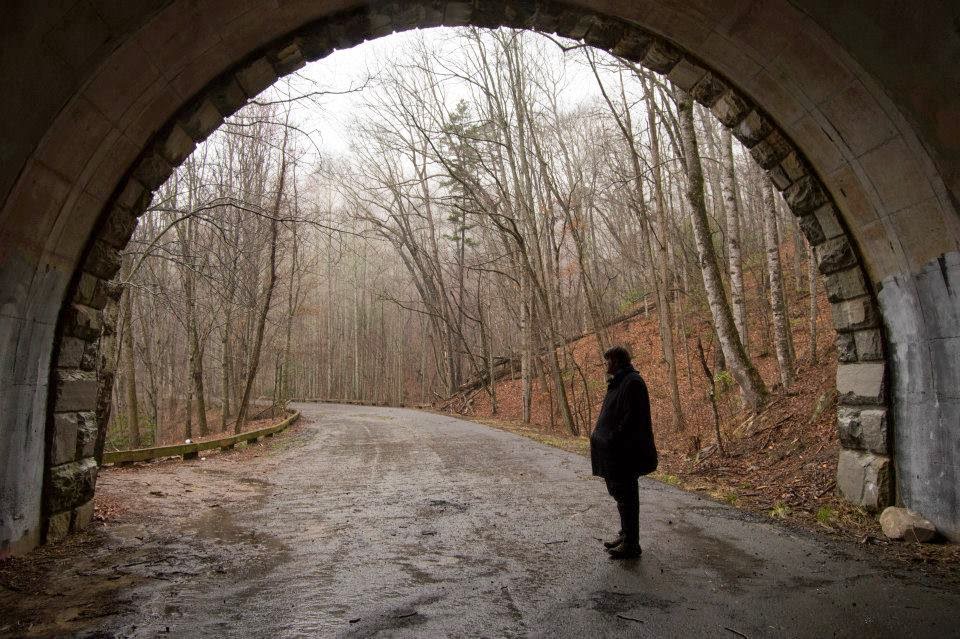 |
| Me at the far end of the tunnel on Lakeview Drvie in GSMNP. Photo by Erin |
East of the Mississippi, however, the story was often different. This is especially true for Shenandoah and Great Smoky Mountains. These parks were built off of previously private land, purchased and (often) seized by the government, much to the chagrin of locals. In establishing Great Smoky Mountains National Park, communities in places such as Sugarlands, Cataloochee, and Cades Cove were dismantled, with all but a few remnant older residents forced off their land, much of which had been in their families for as long a century.
Now, I must state that I am truly in favor of having Shenandoah and Great Smoky Mountains National Parks. They protect beautiful and ecologically important areas of our nation, and without them being intact as they are, the protection wouldn't be as valid. That doesn't change the fact that the methods used by the National Park Service, the Department of the Interior, and other governmental agencies weren't heavy handed or unfair*. To their credit, both parks today don't shy away from their controversial origins, taking a view that good or bad, it's still our history.
What's left, of course, is a collection of ruins, historical buildings, and other remnants of a bygone era. Besides the historic cabins, churches, and the mill of Cades Cove, there are dozens of other historic buildings preserved in the park. As many as there are preserved, there are a multitude of others that have been demolished or rotted away, leaving just foundations and chimneys. Many of these are the remains of old vacation cottages from before the age of the park, but there are also plenty of ruins of homesteads, outbuildings, and other necessary structures for living in Appalachia.
Of course, the story of lost communities in the southeast isn't just limited to the national parks. In the 30s and 40s, another major effort by the Roosevelt administration, the Tennessee Valley Authority, started building dams and lakes along the Tennessee River and its tributaries. One of these was placed along the Little Tennessee River, high up in the mountains at the southwest edge of the Smokies. It was here that Fontana Dam was built. The highest dam east of the Rockies, it created Fontana Lake, a winding narrow lake that rests along the border of the national park for many miles in North Carolina.
 |
| Fontana Dam |
Like many of the TVA lake projects, homesteads and communities were abandoned to make way for progress. Once the dam was built, these places found themselves under water. This included NC State Highway 288, a former connector between Bryson City and the area around Fontana. It's closure, and the creation of the National Park, not only cut off people from their ancestral homelands, it also cut them off from their family cemeteries.
With this in mind, the NPS was working with Swain County and the state of North Carolina to build a replacement for the highway, so the people would be able to access their family plots. The highway would wind high above Fontana Lake near the edge of the park, creating a connector between Bryson City and the small community that developed around Fontana Dam.
After this agreement was made, the road construction began. However, after about seven miles and the construction of one tunnel, work stopped. Environmental issues had been found related to the construction of the road, and the risk was too great to continue work. For decades, the situation smoldered, as the NPS neither continued work nor outright ended the project and the citizens of Swain County fumed at what they perceived to be a broken promise. Finally a deal was brokered a few years back which brokered a settlement, giving millions of dollars to Swain County as restitution for the lost land and the unfinished road.
Because of the fragile nature of the park's ecology, it makes since that the road was not finished. As a form of transportation between Bryson City and Fontana, it is redundant, as NC 28 will get you there almost as fast as the planned Lakeview Drive would have. It's a testament to the evolving nature of the National Park Service, an institution that at one time not only condoned the killing of apex predators and the feeding of bears, but actively encouraged it. While the ecological necessity of halting the road's progress was necessary, it is still unfortunate that the ancestral cemeteries have effectively been cut off. The NPS alleviates this somewhat with special ferries for residents of the county across the lake to the cemeteries in the summer.
As busy as the park is, it's great that there are plenty of wonderful places to visit that aren't quite so crowded as Clingman's Dome or Cade's Cove. Places such as Fontana, Cosby, Balsam Mountain, and along the unpaved back roads in the park offer rewards of their own, Oftentimes without having so many neighbors sharing those rewards.
*This is especially true considering the double standard elsewhere, where ski resorts, golf courses, and the aforementioned uranium mine were allowed to operate in a national park for decades, despite their detriment to the natural balance of the area.
No comments :
Post a Comment